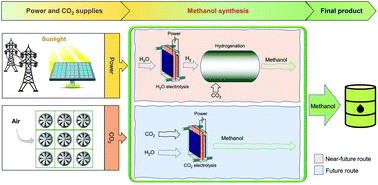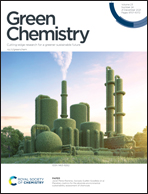Transition pathways towards net-zero emissions methanol production†
Abstract
The race to decarbonize our energy systems has led to significant advancement in technologies for harvesting renewable energy, carbon capture and conversion. Future scenarios are being envisioned where CO2 is captured from air and converted to valuable fuels and chemicals, with methanol (MeOH) being the most coveted product. Here we assess transition pathways for the sustainable production of MeOH using CO2via direct air capture (DAC) and hybrid power via renewable photovoltaic (PV) and grid electricity. Specifically, we perform techno-economic and life-cycle analysis on technologically mature 1st generation (water electrolysis coupled to CO2 hydrogenation) and emerging 2nd generation air-to-MeOH (direct CO2-to-MeOH electrolysis) routes. Our results indicate that the two transition pathways would be economically compelling only in jurisdictions where low-cost ($0.02 per kWh) grid electricity is available. Furthermore, the economic feasibility of the 1st generation route will also depend on a drastic reduction in Si-PV ($300 per kW) and DAC ($280 per ton-CO2 per year) capital costs. On the other hand, the 2nd generation route will additionally need drastic performance improvement to be economically competitive, with required CO2 electrolysis current densities >300 mA cm−2, energy efficiency >50% and stack stability >2 years. The envisioned air-to-MeOH routes could lead to zero or negative CO2 emissions in jurisdictions with clean grid electricity (<50 kg-CO2 per MWh). We hope this study will garner key stakeholders to advance discussions about the cost and potential of this envisioned air-to-fuel technology.

- This article is part of the themed collections: 2021 Green Chemistry Hot Articles and Green Chemistry Reviews


 Please wait while we load your content...
Please wait while we load your content...